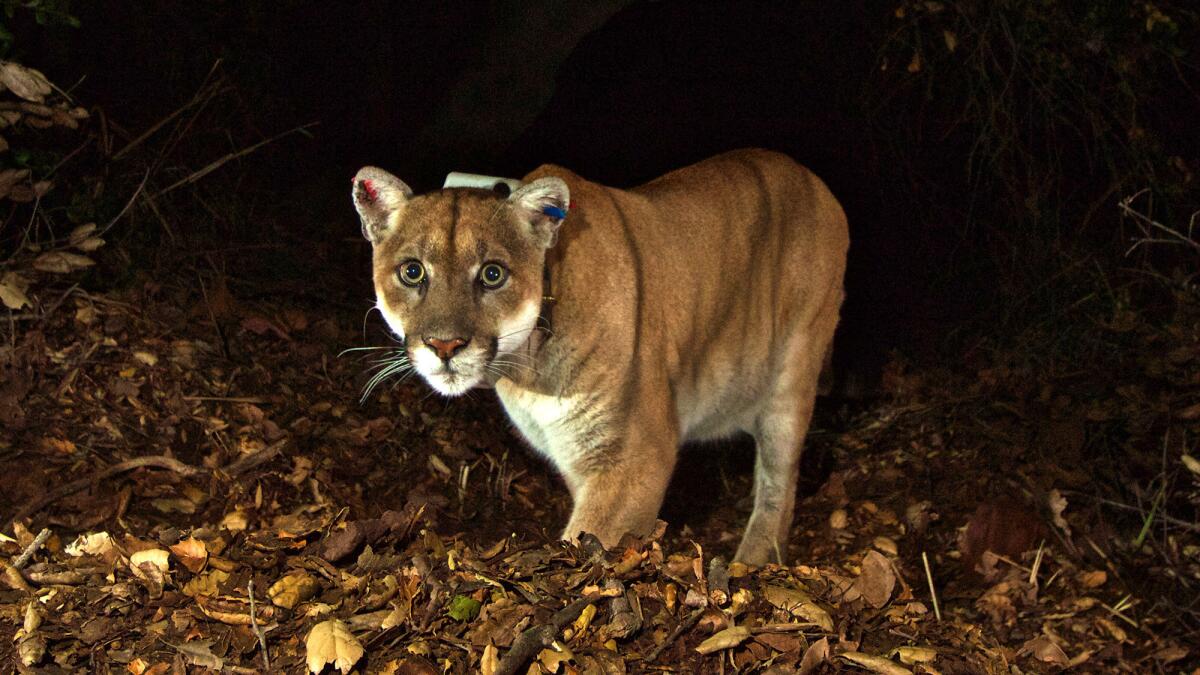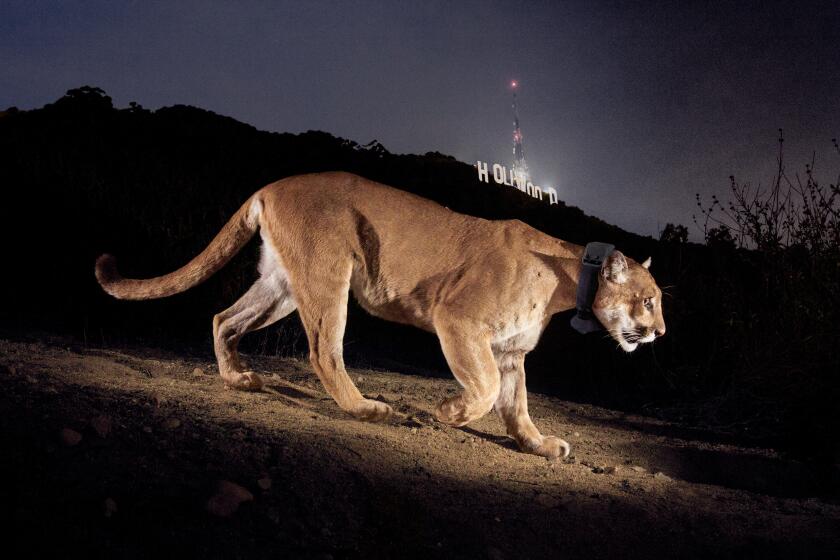P-22, whose death came after a car hit him, was already critically ill, necropsy shows

- Share via
The big cat known as P-22, who eked out his existence in Griffith Park for over 10 years, suffered from kidney disease, arthritis and other chronic conditions before his death in December, according to the final results of a necropsy released Wednesday.
P-22 was euthanized after state wildlife officials captured him and found he was suffering from several long-term health problems as well as injuries from being hit by a car. The final necropsy report showed that skull fracture, which officials said was “consistent with reports of a vehicle strike the night before he was captured.” It also showed injuries from older trauma, including a rupture of the diaphragm through which his liver had herniated into his chest cavity.
The necropsy found a severe parasitic skin infection and a ringworm infection. It also confirmed prior diagnoses that P-22 was “underweight, arthritic and suffering from progressive and incurable kidney disease,” according to a news release.
“We are grateful to the San Diego Zoo Safari Park and Los Angeles Zoo teams,” Dr. Deana Clifford, a senior veterinarian for the California Department of Fish and Wildlife, said in a statement. “They provided excellent care for P-22 and conducted a detailed postmortem examination that shed plenty of light on this cat’s condition.”
The 12-year-old mountain lion also had traces of five rat poisons in his liver, but he was not suffering from the effects of the poisons, the state Department of Fish and Wildlife and the National Park Service said.
The mountain lion P-22, who lived in the heart of Los Angeles for more than a decade and became the face of an international campaign to save Southern California’s threatened pumas, was euthanized Saturday.
One of those poisons, diphacinone, was also detected in P-22’s blood after his capture, which could mean he had been recently exposed, officials said. P-22 was also exposed to this type of poison in 2014, when National Park Service researchers captured and treated him for a skin infection caused by mange.
It’s unclear how P-22 was exposed to bromethalin, another poison that was found in his body fat, but biologists suspect it could have been from an animal that he ate.
P-22, the most famous mountain lion in California, was born in the Santa Monica Mountains and made his home in Griffith Park, surrounded by residential neighborhoods, after he crossed the 405 and 101 freeways. He often passed through streets and yards, showing up on doorbell cameras with his iconic radio collar.
National Park Service researchers track the movement of multiple lions across the region as part of an ongoing big cat study, but P-22 often came the closest to humans.
In December, biologists tracking P-22 recognized that they needed to capture him after he killed a leashed dog and attacked another one a few weeks later.
An anonymous caller had reported a vehicle collision with a mountain lion a few blocks south of Griffith Park, and P-22’s radio collar placed him nearby, officials said. He was found injured in a Los Feliz backyard and appeared anemic. He was taken to the San Diego Zoo under the care of wildlife health doctors, but officials realized that P-22 was too ill and injured to be released back into the wild.
The mountain lion known as P-22 has become something of a celebrity in Los Angeles. After killing a chihuahua and acting erratically, he was found in a Los Feliz backyard and taken for evaluation.
Parks and wildlife officials decided to euthanize P-22 to give him his “last best day” rather than prolong his suffering, Chuck Bonham, director of the California Department of Fish and Wildlife, said during an emotional news conference.
P-22’s life and death captured the attention of Angelenos during the decade he called Griffith Park home, including his forays into residential neighborhoods or when he decided to camp out under a home in Los Feliz.
“P-22 was a fascinating animal to study,” Jeff Sikich, lead field biologist with the National Park Service mountain lion study, said in a statement.
“Not only was he an important ambassador for urban wildlife, but his scientific contributions were also many. He helped us understand how mountain lions coexist with humans in this complex urban landscape, and his legacy will live on through our heightened awareness of how to live in harmony with wild neighbors and growing public support for wildlife crossings.”
The big cat became a figurehead for a $30-million wildlife crossing over a 10-lane stretch of the 101 Freeway in Agoura Hills. The crossing is meant to give mountain lions the freedom to cross between the Santa Monica Mountains without having to dart across the freeway, much like P-22 did when he was young. The Wallis Annenberg Wildlife Crossing is expected to be completed in 2025.
More to Read
Sign up for Essential California
The most important California stories and recommendations in your inbox every morning.
You may occasionally receive promotional content from the Los Angeles Times.













